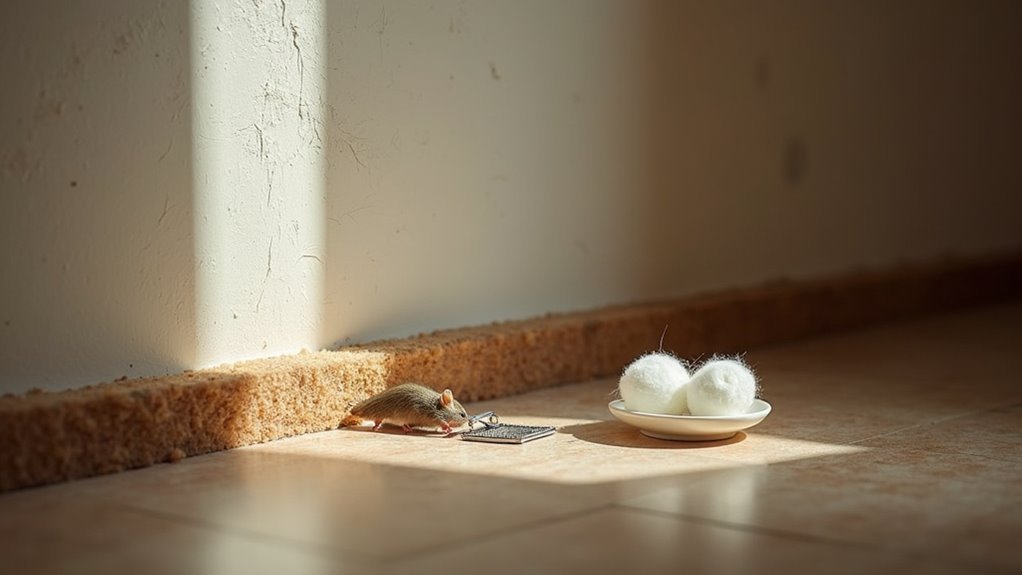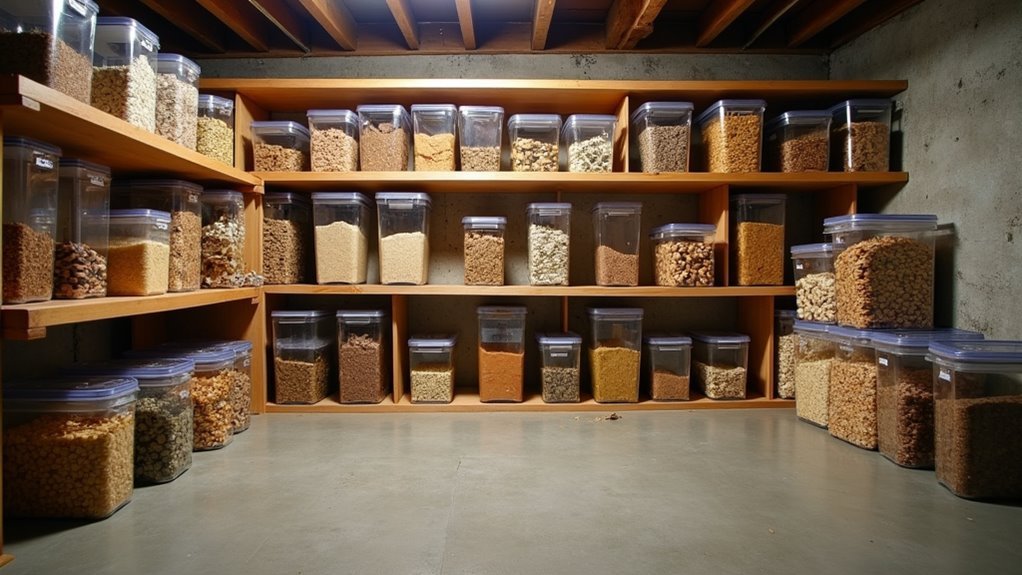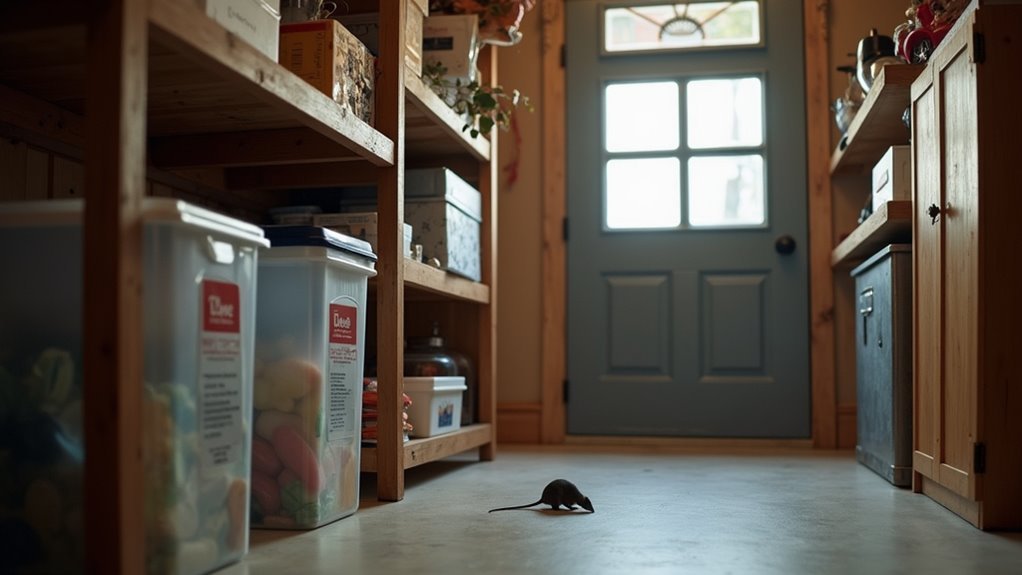You can effectively prevent basement mice by sealing entry points with steel wool and caulk, storing all food in chew-proof containers, and eliminating moisture sources through proper ventilation and leak repairs. Place snap traps in T-formations along walls where you’ve spotted droppings, checking them daily for best results. Install metal barriers around foundation gaps and maintain regular cleaning routines to remove crumbs and potential nesting materials. These extensive strategies will reveal additional protective measures for long-term success.
Understanding Mouse Behavior in Basements

Before you can effectively prevent mice in your basement, you’ll need to understand how these persistent rodents behave in underground spaces. Mice can squeeze through gaps as small as a dime, making your basement extremely vulnerable if entry points aren’t properly sealed.
These nocturnal creatures explore your basement during nighttime hours, leaving droppings and urine trails to mark their territory as they move around.
Mice mark their basement territory with droppings and urine as they scavenge during nighttime hours.
You’ll find they prefer nesting in soft, hidden areas like wall voids and unfinished corners where they won’t be disturbed. They’re actively searching for food sources, especially near kitchen areas, and will contaminate stored items by nibbling through packaging.
Their powerful jaws can chew through wires and insulation, creating additional structural damage beyond the initial infestation.
Identifying Signs of Mouse Activity
You’ll need to look for specific warning signs that indicate mice have invaded your basement space.
Fresh droppings in corners, gnaw marks on stored items, and unusual nests made from shredded materials are the most reliable indicators of an active infestation.
These telltale signs will help you determine whether you’re dealing with a current problem or just remnants from past activity.
Fresh Droppings and Location
Fresh mouse droppings serve as one of the most reliable indicators of active rodent presence in your home. You’ll typically find these dark, moist pellets in specific locations where mice frequent most often.
| Location | Why Mice Choose It |
|---|---|
| Kitchen drawers | Easy food access |
| Under sinks | Water source nearby |
| Food pantries | Abundant food supply |
| Cabinet corners | Safe hiding spots |
Fresh droppings appear darker and moister than older ones, making them easy to distinguish. House mouse droppings measure about 1/4 inch, considerably smaller than rat droppings. Check these areas regularly, as discovering fresh droppings indicates recent activity. Large quantities of droppings or daytime sightings suggest serious rodent infestations requiring immediate attention.
Gnaw Marks and Damage
Beyond droppings, mice leave another telltale sign of their presence through destructive gnawing behavior. You’ll discover gnaw marks on cardboard boxes, food packages, and wooden structures as mice search for nesting materials and sustenance.
These persistent rodents can chew through insulation, electrical wires, and even walls, creating serious hazards like potential electrical fires.
The size of gnaw marks helps you identify the culprit—house mice create smaller marks than larger Norway rats. Fresh gnawing typically appears alongside dark, moist droppings, confirming active infestations requiring immediate Mouse Control measures.
Conduct regular inspections for gnaw marks and associated damage throughout your basement. Early detection prevents extensive infestations and costly repairs, making routine monitoring essential for effective rodent management.
Nests and Strange Odors
Two distinct indicators often reveal mouse activity before you spot the rodents themselves: makeshift nests and musty odors that permeate affected areas.
You’ll discover these nests constructed from shredded materials like paper, fabric, lint, or dried plants tucked away in dark, secluded spots throughout your basement. Check behind stored boxes, inside old furniture, or within wall cavities where mice feel secure.
The distinctive odors accompanying these nests serve as unmistakable warning signs of infestation. You’ll notice a musty, ammonia-like smell that intensifies near active nesting sites.
This odor results from accumulated urine, droppings, and the natural scent mice use for territorial marking. Don’t ignore these smells – they indicate established mouse populations that require immediate intervention before the problem escalates considerably.
Sealing Entry Points and Foundation Gaps
You’ll need to thoroughly inspect your basement foundation for any gaps or cracks, since mice can squeeze through openings as small as a dime.
Focus your attention on areas where plumbing and electrical utilities enter your home, as these represent the most common access points for rodents.
Install metal barriers like steel wool, hardware cloth, or stainless steel mesh to permanently block these entry points and prevent future infestations.
Inspect Foundation for Gaps
Since mice can squeeze through openings as small as 1/4 inch, inspecting your foundation becomes one of the most critical steps in preventing an infestation.
When you inspect foundation for gaps, you’re identifying potential access points before they become major problems.
Focus your inspection on these key areas:
- Utility entry points – Check where pipes, cables, and wires enter your home
- Foundation cracks – Look for hairline fractures and settling damage along the entire perimeter
- Corner joints – Examine where foundation walls meet, as these areas often develop gaps
- Ground-level openings – Inspect vents, basement windows, and door frames for worn weatherstripping
Regular inspections help you catch small gaps before they worsen, ensuring your prevention efforts remain effective year-round.
Seal Utility Entry Points
After identifying gaps during your foundation inspection, you’ll need to tackle the utility entry points where pipes, cables, and electrical wires penetrate your home’s exterior walls.
These areas are prime targets for mice since they’re often overlooked during construction.
Start by examining where plumbing and electrical systems enter your basement. You’ll find gaps around these utilities that mice exploit regularly.
For small openings, pack steel wool tightly into the space, then seal with caulk. Mice can’t chew through steel wool, making this combination highly effective.
Larger gaps require hardware cloth or cement for proper sealing.
Don’t forget exterior vents—install proper screening that allows airflow while blocking access.
These proactive steps greatly strengthen your control efforts against unwanted rodent intrusions.
Install Metal Barriers
While steel wool and caulk work well for smaller gaps, metal barriers provide the most robust defense against persistent mice trying to breach your foundation and entry points.
Mice can squeeze through openings as small as a dime, making thorough protection essential.
Here’s how to install effective metal barriers:
- Apply metal flashing around foundation perimeters – Secure flashing along the base of your home where walls meet the ground, creating an impenetrable barrier.
- Install stainless steel mesh over gaps around plumbing and utility lines – Block any openings less than 1/4 inch wide with tightly fitted mesh.
- Reinforce door frames and vents – Add metal strips around these vulnerable entry points.
- Regularly inspect and maintain all barriers – Verify secure fastening prevents mice from finding new routes inside.
Installing Door Sweeps and Weatherstripping
When mice find their way into your home, they’re often squeezing through the smallest gaps beneath doors and around door frames. Installing door sweeps and weatherstripping creates essential barriers that prevent rodent entry while improving your home’s energy efficiency.
| Material | Durability | Rodent Resistance | Cost | Best Use |
|---|---|---|---|---|
| Metal door sweeps | High | Excellent | Moderate | Exterior doors |
| Rubber door sweeps | Medium | Good | Low | Interior doors |
| Foam weatherstripping | Low | Poor | Very low | Temporary fixes |
| Vinyl weatherstripping | Medium | Good | Low | Windows/doors |
| Silicone weatherstripping | High | Excellent | High | Long-term sealing |
Focus on exterior doors, garages, and sheds where gaps commonly occur. Verify door sweeps extend completely across doors and seal tightly to thresholds. Regularly inspect and replace worn materials to maintain effective protection against unwanted rodent visitors.
Proper Food Storage and Container Selection

Since mice possess an extraordinary sense of smell that can detect food sources from significant distances, you’ll need to eliminate every potential food attraction in your home through strategic storage methods.
Transform your basement into a fortress against rodents by implementing these essential storage practices:
- Transfer all opened packages of snacks, pet food, and grains into chew-proof containers made of thick plastic, metal, or ceramic materials immediately after opening.
- Clean spills and crumbs promptly after meal preparation to eliminate lingering food scents that attract mice.
- Inspect storage areas regularly for damaged containers or food leakage, as even tiny amounts can draw rodents.
- Secure garbage containers with tight-fitting lids and maintain food in sealed containers to prevent access through quarter-inch gaps.
Basement Sanitation and Cleaning Methods
You’ll need to tackle two critical areas to keep mice out of your basement: removing food sources and eliminating nesting materials.
Start by cleaning up any spills, crumbs, or food debris that’s accumulated in corners, around appliances, and near storage areas.
Clear out clutter like old boxes, fabric scraps, and paper materials that mice can use to build their nests.
Remove Food Sources
Three essential steps form the foundation of effective basement mouse prevention: securing food storage, maintaining cleanliness, and eliminating attractants.
Removing every food source is your most powerful rodent control strategy.
Here’s how to eliminate food sources effectively:
- Store all food in chew-proof containers – Use thick plastic, metal, or ceramic containers for human and pet food to prevent access.
- Clean spills immediately – Maintain a regular cleaning schedule to eliminate food scent trails that draw mice to your basement.
- Secure garbage containers – Confirm all waste bins have tight-fitting lids and empty them regularly to prevent scavenging.
- Remove clutter and inspect storage areas – Clear old boxes and unused items while checking for forgotten food packages that could attract rodents.
Eliminate Nesting Materials
While removing food sources cuts off their supply line, eliminating nesting materials destroys mice’s ability to establish permanent residence in your basement.
You’ll need to remove old furniture, appliances, and debris piles that provide cozy hiding spots. Store remaining items in sealed containers made of thick plastic or metal – mice can’t chew through these materials.
Focus on eliminating soft material like cardboard boxes, paper stacks, and fabric scraps that mice love for building nests.
Vacuum and wipe surfaces regularly to remove droppings, urine spots, and accumulated dust. Clear out storage areas completely, ensuring no soft materials remain accessible.
Establish a consistent cleaning schedule to prevent future accumulation of nesting materials and maintain your mouse-free basement environment.
Eliminating Water Sources and Moisture Control

Since mice need only a teaspoon of water daily to survive, eliminating moisture sources becomes essential for effective rodent control. Your basement’s damp environment attracts rodents and creates ideal nesting conditions.
Moisture control requires an all-encompassing approach targeting all potential water sources.
Key strategies for eliminating water sources:
- Fix plumbing leaks immediately – Inspect your basement regularly and repair any drips or standing water that provide crucial hydration for mice.
- Control humidity levels – Use a dehumidifier to maintain humidity below 50%, making your basement less attractive to rodents.
- Improve drainage systems – Direct downspouts away from your foundation and grade soil to prevent water pooling near basement walls.
- Enhance ventilation – Open windows or use fans to reduce moisture buildup and create an unwelcoming environment for mice.
Strategic Trap Placement Techniques
Beyond controlling moisture in your basement, proper trap placement determines the success of your mouse elimination efforts.
Position snap traps in a T formation along walls with the baited end closest to the wall, following mice’s natural travel patterns. Space your traps 2-10 feet apart in high-activity areas where you’ve spotted droppings or gnaw marks.
Deploy multiple traps throughout different basement locations to cover various entry points and potential nesting sites. This strategy maximizes your capture rates and guarantees thorough rodent control.
Check traps daily to maintain functionality and replace bait when needed.
Always place traps in concealed areas to prevent pets or other animals from accessing them, ensuring both safety and effectiveness of your trap placement strategy.
Effective Natural Bait Options
Once you’ve positioned your traps strategically, selecting the right bait becomes essential for maximizing capture success. The most effective rodent baits appeal to mice’s natural preferences and feeding behaviors.
Strategic trap placement means nothing without the right bait to appeal to mice’s natural feeding instincts and preferences.
Here are four proven natural bait options:
- Peanut butter – Use a pea-sized amount; its strong aroma and sticky texture make it irresistible to mice.
- Soft cheese – Place small pieces that’ll attract mice without easily falling off the trap trigger.
- Wet cat food – The protein-rich scent draws hungry rodents effectively.
- Nesting materials – Cotton or string offers pet-safe alternatives while appealing to mice’s shelter instincts.
When you place the bait, secure it firmly to prevent easy removal.
Change baits regularly to maintain interest, and monitor which options work best for your specific situation.
Using Natural Deterrents and Repellents
Natural deterrents offer an effective, chemical-free approach to keeping mice away from your home before they establish themselves.
You can use peppermint oil, garlic, and vinegar as powerful repellents since mice are sensitive to these strong odors. Place coffee grounds and dried chili peppers in areas where you’ve noticed mouse activity – their intense scents create an unwelcoming environment.
Try scattering human hair clippings around problem areas, as this signals potential predators nearby.
Cotton balls soaked in essential oils like peppermint or eucalyptus work exceptionally well when placed strategically throughout your basement.
Remember that consistency is key with natural deterrents. You’ll need to reapply these repellents regularly to maintain their effectiveness and markedly reduce mouse activity in your basement.
Outdoor Prevention Around Foundation
While indoor deterrents work well, you’ll achieve better results by creating an unwelcoming environment around your home’s foundation.
Professional pest control company tactics focus heavily on exterior prevention because it’s more effective than battling mice once they’re inside.
Prevention at your home’s perimeter proves far more effective than chasing mice that have already established themselves indoors.
Transform your property’s perimeter with these essential steps:
- Clear shelter materials – Remove woodpiles, tall grass, and leaf accumulations that create hide spots for mice around your foundation.
- Maintain proper landscaping – Trim vegetation touching your home and establish a 2-foot buffer zone between mulch or plants and the foundation.
- Secure food sources – Store outdoor pet food and bird seed in sealed containers.
- Conduct regular inspections – Check for droppings or gnaw marks to catch activity early.
Regular Monitoring and Maintenance Schedule
Even the most thorough prevention efforts require consistent monitoring to remain effective against persistent mice.
You’ll need to establish a bi-weekly inspection routine, checking for droppings, gnaw marks, and nests throughout your basement. This monitoring schedule helps you catch problems early before they escalate.
Create a monthly cleaning routine that eliminates potential food sources and removes clutter that attracts mice.
Clean up spills and crumbs immediately to maintain your preventive barrier. Conduct seasonal checks of all entry points, sealing new gaps that develop from weather changes or settling.
Rotate your bait and traps every 4-6 weeks to maintain effectiveness.
Document your findings during each inspection to track patterns and adjust your preventive strategies accordingly for long-term success.
Frequently Asked Questions
What Can I Put in My Basement to Keep Mice Out?
You can place cotton balls soaked in peppermint oil or vinegar around your basement, install door sweeps, seal gaps with steel wool, and store food in chew-proof containers to deter mice effectively.
What Is the Fastest Way to Get Rid of Mice in the Basement?
Set snap traps along basement walls in T formations, spacing them 2-10 feet apart. Use peanut butter as bait and change it regularly. You’ll see results within days using this most effective removal method.
Does Irish Spring Soap Really Repel Mice?
You’ll find mixed results with Irish Spring soap as a mouse repellent. While many homeowners swear by its strong scent deterring rodents, there’s limited scientific proof it’s consistently effective for mouse control.
What Is the Best Homemade Mouse Repellent for a House?
You’ll find peppermint oil works best as a homemade mouse repellent. Soak cotton balls in peppermint oil and place them around entry points. Refresh regularly since the scent fades, reducing effectiveness over time.
In Summary
You’ve got the tools to keep mice out of your basement for good. Seal those entry points, store food properly, and maintain regular monitoring. Don’t forget to address outdoor issues around your foundation. Stay consistent with your prevention routine, and you’ll catch problems before they become infestations. Your basement will remain mouse-free when you combine these proven DIY strategies with ongoing vigilance.





Leave a Reply